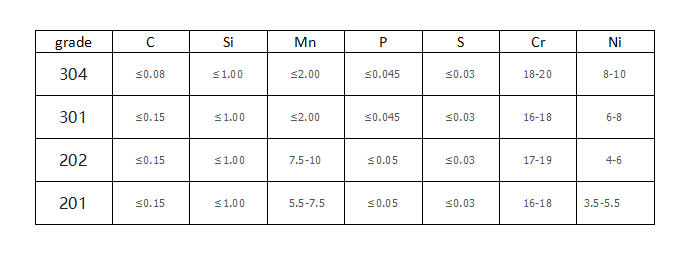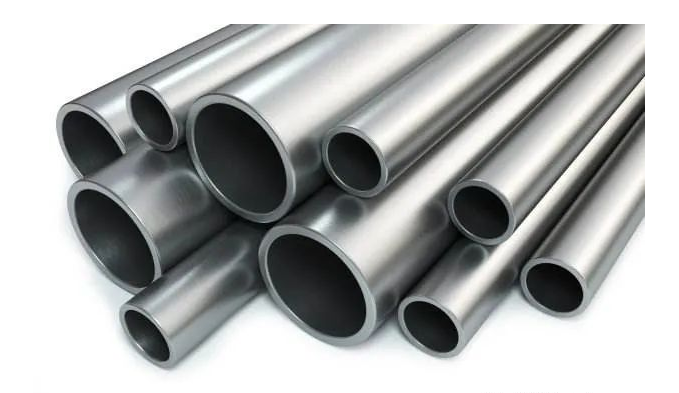1.What kind of steel is stainless steel?
Stainless steel is a kind of steel. Steel refers to steel with less than 2% carbon (c), and iron with more than 2%. In the smelting process of steel, chromium (CR), nickel (Ni), manganese (MN), silicon (SI), titanium (TI), molybdenum (MO) and other alloy elements are added to improve the performance of steel and make the steel have corrosion resistance (i.e. no rust), which is what we often call stainless steel.
2.Why does stainless steel have different steel grades?
In the smelting process of stainless steel, due to the different varieties of alloy elements, the amount of different varieties is different. Its characteristics are also different. In order to distinguish, different steel grades are crowned. The following is the content table of “alloy elements” of common stainless steel with different steel grades for reference only:

3.What kind of stainless steel is not easy to rust?
There are three main factors affecting stainless steel corrosion:
1) Generally speaking, steel is not easy to rust when the content of alloy elements is 10.5%. The higher the content of chromium and nickel, the better the corrosion resistance. For example, the nickel content of 304 material is 8-10%, and the chromium content reaches 18-20%. Such stainless steel will not rust under normal circumstances.
2) The smelting process of manufacturing enterprises will also affect the corrosion resistance of stainless steel. Large stainless steel plants with good smelting technology, advanced equipment and advanced process can be guaranteed in terms of alloy element control, impurity removal and billet cooling temperature control. Therefore, the product quality is stable and reliable, the internal quality is good, and it is not easy to rust. On the contrary, some small steel mills have backward equipment and technology. During the smelting process, impurities cannot be removed, and the products produced will inevitably rust.
3) The external environment is dry, and the environment with good ventilation is not easy to rust. However, areas with high air humidity, continuous rainy weather, or high pH in the air are prone to rust. 304 stainless steel will rust if the surrounding environment is too poor.
4.Stainless steel does not have magnetism. Is it good stainless steel without magnetism? If the micro strip is magnetized, isn’t it 304?
Many customers go to the market to buy stainless steel and bring a small magnet with them. When looking at the goods, they suck it. They think that what they can’t suck is good stainless steel. Without magnetism, there will be no rust. In fact, this is a wrong understanding.
Whether stainless steel is magnetic or not is determined by the structure. Due to different solidification temperatures, molten steel will form stainless steel with different structures such as “ferrite”, “austenite” and “martensite”, among which “ferrite” and “martensite” stainless steel are magnetic. The “austenitic” stainless steel has good comprehensive mechanical properties, process properties and weldability, but only in terms of corrosion resistance, the magnetic “ferrite” stainless steel is stronger than the “austenitic” stainless steel. At present, the so-called 200 series and 300 series stainless steels with high manganese content and little nickel content circulating in the market do not have magnetism, but their performance is far from that of 304 with high nickel content. On the contrary, 304 will also have micro magnetism after stretching, annealing, polishing, casting and other processes. Therefore, it is a misunderstanding and unscientific to judge the advantages and disadvantages of stainless steel with or without magnetism.
5.Why does stainless steel rust?
When there are brown rust spots (spots) on the surface of stainless steel, people are surprised: they think that “stainless steel will not rust, rust is not stainless steel, maybe there is something wrong with the steel”. In fact, this is a one-sided wrong view of the lack of understanding of stainless steel. Stainless steel will rust under certain conditions.
Stainless steel has the ability to resist atmospheric oxidation, that is, rust resistance. At the same time, it also has the ability to resist corrosion in the medium containing acid, alkali and salt, that is, corrosion resistance. However, its corrosion resistance changes with the chemical composition of the steel itself, the mutual state, the service conditions and the type of environmental medium. For example, 304 material has absolutely excellent corrosion resistance in a dry and clean atmosphere, but if it is moved to the coastal area, it will soon rust in the sea fog containing a lot of salt. Therefore, not any kind of stainless steel can resist corrosion and rust at any time.
Stainless steel relies on a thin, firm and fine stable chromium rich oxide film (protective film) formed on its surface to prevent oxygen atoms from continuing to penetrate and oxidize, so as to obtain corrosion resistance. Once for some reason, this film is constantly destroyed, oxygen atoms in air or liquid will continue to penetrate or iron atoms in the metal will continue to separate out, forming loose iron oxide, and the metal surface will be constantly corroded. There are many forms of damage to this surface facial mask, and the following are common in daily life:
1) Dust containing other metal elements or attachments of dissimilar metal particles are stored on the surface of stainless steel, and
In the air, the condensed water between the attachment and stainless steel connects them into a micro battery, which triggers an electrochemical reaction and destroys the protective film, which is called electrochemical corrosion.
2) The surface of stainless steel is adhered with organic juice (such as melons and vegetables, noodles, soup, phlegm, etc.), which forms organic acids in the presence of water and oxygen, and forms the corrosion of organic acids on the metal surface for a long time.
3) The adhesion of stainless steel surface contains acid, alkali and salt substances (such as alkali water and lime water spray measurement of decoration walls), which cause local corrosion.
4) In polluted air (atmosphere containing a large amount of sulfide, oxide and hydrogen oxide), when encountering condensed water, sulfuric acid, nitric acid and acetic acid liquid points are formed, causing chemical corrosion.
The above conditions can cause the damage and corrosion of the protective film on the surface of stainless steel. Therefore, in order to ensure that the metal surface is permanently bright and not rusted, we suggest:
① The decorative stainless steel surface must be cleaned and scrubbed frequently to remove attachments and external factors that cause corrosion.
② At present, there is a kind of 201 and 202 stainless steel on the market, which is easy to rust in coastal areas, and is suitable for use in an environment without industrial pollution and air corrosion.
③ 304 stainless steel should be used in coastal areas, which can resist seawater corrosion.
6.How to deal with rust spots on stainless steel?
1) Chemical method:
Use pickling paste or spray to assist its rusted parts to re passivate and form chromium oxide film to restore its corrosion resistance. After pickling, in order to remove all pollutants and acid residues, it is very important to wash it properly with clean water. After all processing, use polishing equipment to polish again, and then seal with polishing wax. For those with slight rust spots locally, you can also use a 1:1 mixture of gasoline and engine oil to wipe the rust spots with a clean rag.
2) Mechanical method:
Blast cleaning, shot blasting with glass or ceramic particles, annihilation, brushing and polishing. It is possible to wipe away the pollution caused by polishing materials or annihilation materials by mechanical methods. All kinds of pollution, especially foreign iron particles, may become a source of corrosion, especially in humid environments. Therefore, the mechanically cleaned surface should preferably be regularly cleaned under dry conditions. Using mechanical method can only clean its surface, and cannot change the corrosion resistance of the material itself. Therefore, it is recommended to re polish with polishing equipment after mechanical cleaning and seal with polishing wax.


